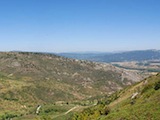Christophe Kolodka PhD thesis
 Evaporitic deformation control on sedimentary architecture: field-based and stratigraphic modelling approaches (examples from Northern and Southeastern Spain)
Evaporitic deformation control on sedimentary architecture: field-based and stratigraphic modelling approaches (examples from Northern and Southeastern Spain)
Defended on the 5th December 2013
Funding: CIFRE (industrial convention of formation by research)
Supervisors: Emmanuelle Vennin and Guy Desaubliaux (GDF-Suez)
Started in March 2010
Abstract
Evaporitic deformation and its most emblematic structures the salt diapirs have always stimulated the geoscientist interest. They result from complex interactions between tectonics, sedimentary loading and the physical properties of evaporites (viscous behaviour). Evaporitic deformation disturbs the record sedimentary allowing to charactize their kinematics and origin. A multidisciplinary study, based on two case-studies, including fieldwork and stratigraphic modelling is performed to explore different aspect of halokinetic-controls on sedimentation. The first one corresponds to the stratigraphic modelling of the Sorbas Basin (SE Spain) infilling during the end-Messinian salinity crisis. It records the development of mixed carbonate-siliciclastic platforms which are partly controlled by evaporitic deformation. Deformation structures recorded in the Sorbas Basin are similar to those generally observed in passive margin settings (rollovers and turtle-back antiforms). A quantitative approach demonstrates that evaporitic deformation locally changes accommodation space and the depocentre distribution. It confirms also the significance of evaporitic deformation on the turnover in carbonate production from an ooid- to a microbialite-dominated system. The second case study corresponds to the Poza de la Sal diapir, which records a multiphase activity in relation with the regional structuration. A first diapir-rise period caused by the rifting of the northern Iberian margin is recorded between the Upper Jurassic and the Lower Cretaceous. The diapir was reactivated during the Cenozoic compressive phase related to the Pyrenean orogeny. A detailed study of the syn-orogenic deposits allows to decipher a local diapir control from a regional one. This work presents several implications in the understanding on the evaporitic deformation control on sedimentation and especially about its sedimentary architecture prediction and distribution. These case studies are compared to others examples in passive margin and compressive context providing new reproducible models in hydrocarbon exploration.
Keywords
evaporitic deformation, sedimentation/evaporitic deformation relationships, diapirism, gravity instabilities, stratigraphic modelling, carbonate platforms, alluvial fans
- extrait:
- lien_externe:
- kc_data:
- a:8:{i:0;s:0:"";s:4:"mode";s:0:"";s:3:"css";s:0:"";s:9:"max_width";s:0:"";s:7:"classes";s:0:"";s:9:"thumbnail";s:0:"";s:9:"collapsed";s:0:"";s:9:"optimized";s:0:"";}
- kc_raw_content:
 Evaporitic deformation control on sedimentary architecture: field-based and stratigraphic modelling approaches (examples from Northern and Southeastern Spain)
Evaporitic deformation control on sedimentary architecture: field-based and stratigraphic modelling approaches (examples from Northern and Southeastern Spain)Defended on the 5th December 2013
Funding: CIFRE (industrial convention of formation by research)
Supervisors: Emmanuelle Vennin and Guy Desaubliaux (GDF-Suez)
Started in March 2010
Abstract
Evaporitic deformation and its most emblematic structures the salt diapirs have always stimulated the geoscientist interest. They result from complex interactions between tectonics, sedimentary loading and the physical properties of evaporites (viscous behaviour). Evaporitic deformation disturbs the record sedimentary allowing to charactize their kinematics and origin. A multidisciplinary study, based on two case-studies, including fieldwork and stratigraphic modelling is performed to explore different aspect of halokinetic-controls on sedimentation. The first one corresponds to the stratigraphic modelling of the Sorbas Basin (SE Spain) infilling during the end-Messinian salinity crisis. It records the development of mixed carbonate-siliciclastic platforms which are partly controlled by evaporitic deformation. Deformation structures recorded in the Sorbas Basin are similar to those generally observed in passive margin settings (rollovers and turtle-back antiforms). A quantitative approach demonstrates that evaporitic deformation locally changes accommodation space and the depocentre distribution. It confirms also the significance of evaporitic deformation on the turnover in carbonate production from an ooid- to a microbialite-dominated system. The second case study corresponds to the Poza de la Sal diapir, which records a multiphase activity in relation with the regional structuration. A first diapir-rise period caused by the rifting of the northern Iberian margin is recorded between the Upper Jurassic and the Lower Cretaceous. The diapir was reactivated during the Cenozoic compressive phase related to the Pyrenean orogeny. A detailed study of the syn-orogenic deposits allows to decipher a local diapir control from a regional one. This work presents several implications in the understanding on the evaporitic deformation control on sedimentation and especially about its sedimentary architecture prediction and distribution. These case studies are compared to others examples in passive margin and compressive context providing new reproducible models in hydrocarbon exploration.
Keywords
evaporitic deformation, sedimentation/evaporitic deformation relationships, diapirism, gravity instabilities, stratigraphic modelling, carbonate platforms, alluvial fans
